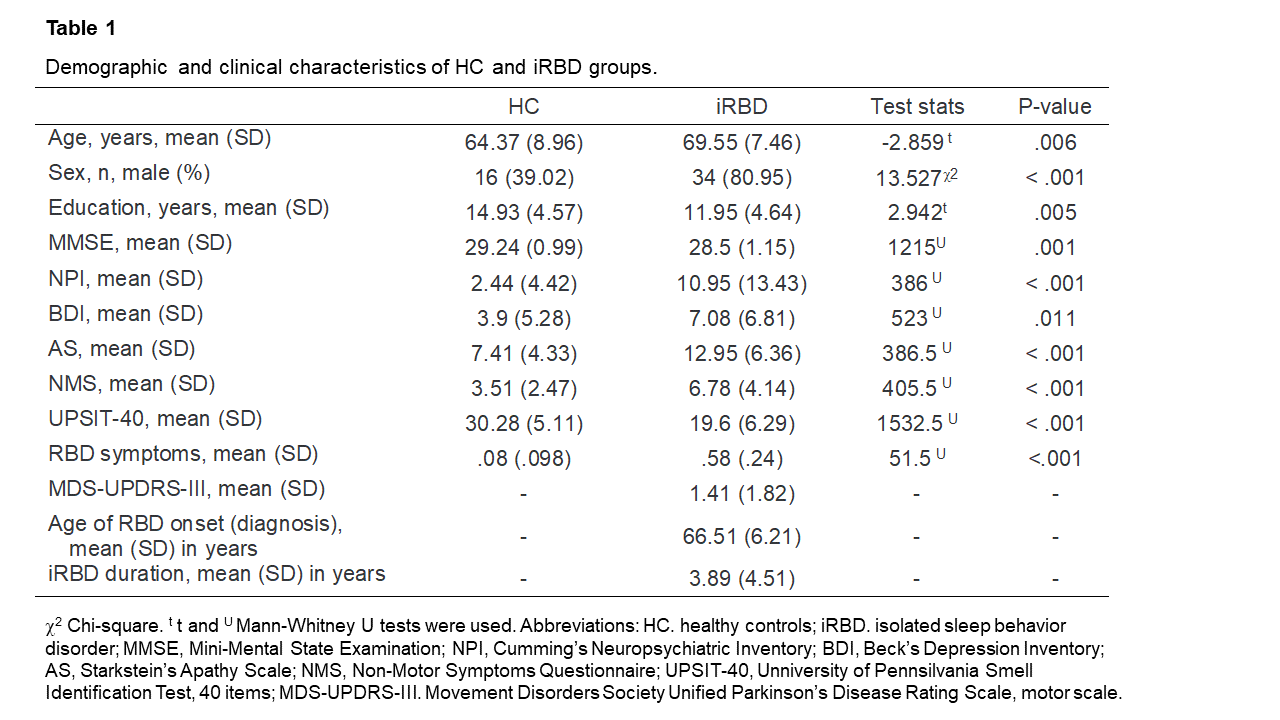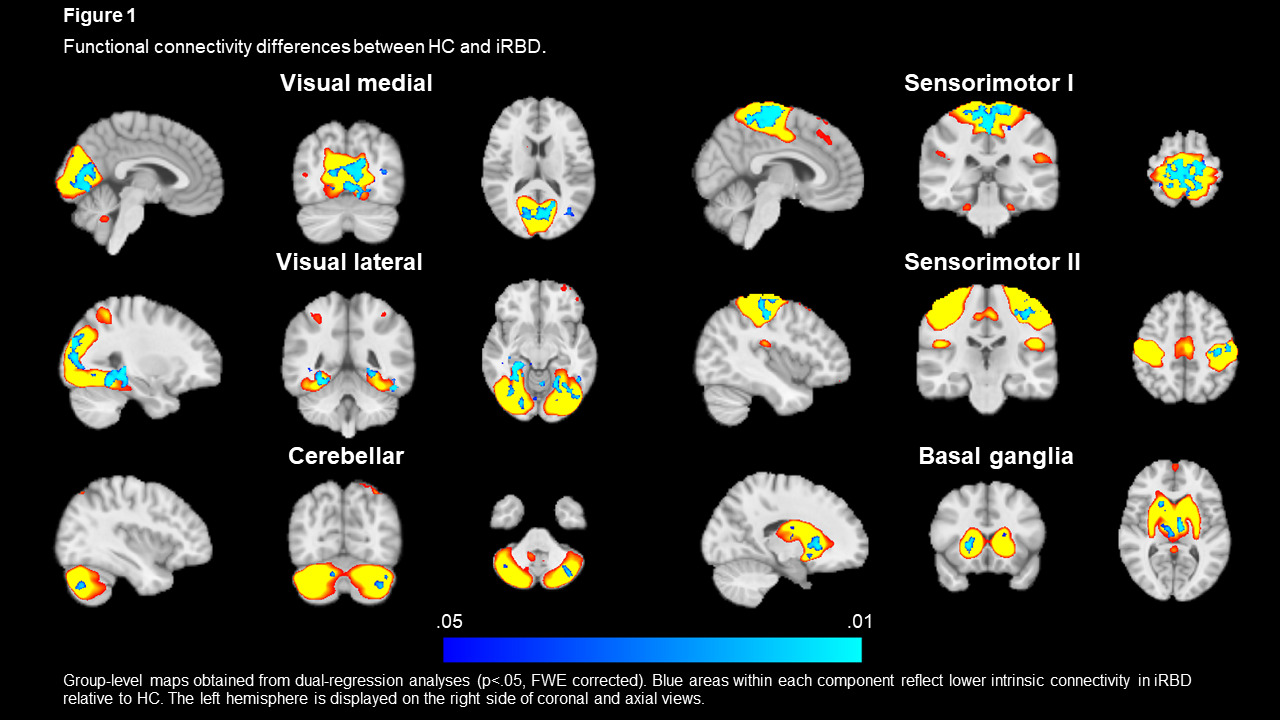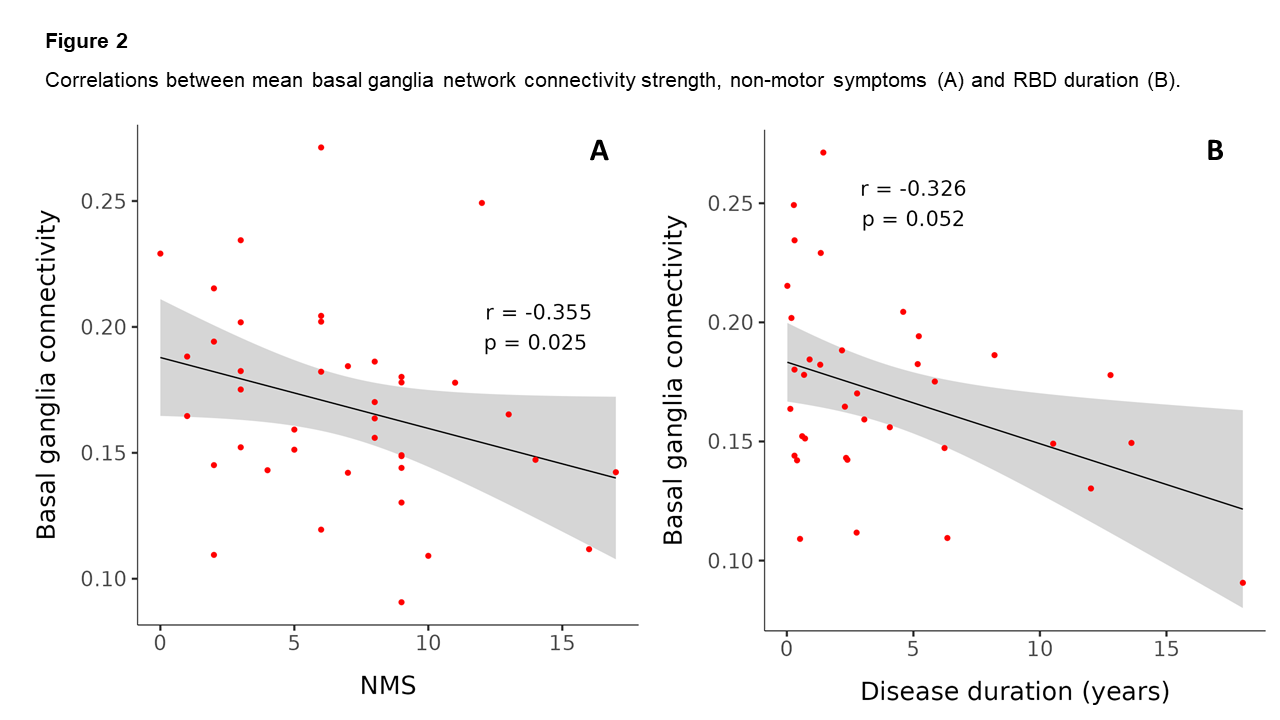Category: Parkinson's Disease: Neuroimaging
Objective: To characterize brain functional connectivity (FC) in patients with isolated REM sleep behavior disorder (iRBD) and its associations with clinical features.
Background: Patients with iRBD are at high risk of conversion to alpha-synucleinopathies such as Parkinson’s disease. Resting-state FC alterations have been described in iRBD, mainly involving the basal ganglia and executive-control networks [1]. However, the associations between FC alterations and the presence of synucleinopathy-related clinical symptoms in iRBD are unknown.
Method: We examined 42 patients with video-polysomnography-confirmed iRBD recruited from the Sleep Center of the Hospital Clinic de Barcelona, Spain, and 41 healthy controls (HC). All participants underwent clinical examination including the assessment of motor and non-motor features, and resting-state functional magnetic resonance imaging (fMRI) in a 3T scanner. Independent Component Analyses were performed on fMRI data to characterize resting-state networks (RSNs). The dual-regression approach [2] including age and sex as covariates was applied to study RSNs between-group differences in FC and threshold-free cluster enhancement (TFCE) was used to correct for multiple comparisons [3]. Correlation analyses were performed between mean RSNs FC strength and clinical scores in the iRBD group. A threshold of p<.05 was used in all the analyses.
Results: Patients with iRBD displayed more frequent and severe non-motor symptoms than HC [table 1] (FDR corrected, P-value ≤ 0.05) and lower intrinsic connectivity within basal ganglia, sensorimotor, cerebellar, visual medial and visual lateral networks [figure 1] (TFCE corrected, P-value ≤ 0.05). Mean FC strength within the basal ganglia network negatively correlated with the presence of non-motor symptoms in patients with iRBD [figure 2]. Additionally, a tendency towards a negative association between iRBD duration and basal ganglia network mean FC strength was observed [figure 2]. No associations were found between RSNs FC strength and age of iRBD diagnosis or clinical symptoms.
Conclusion: Decreased RSNs FC in video-polysomnography-confirmed iRBD extend beyond the basal ganglia network affecting connectivity within visual, sensorimotor and cerebellar networks. Connectivity strength within the basal ganglia network is associated with the presence of non-motor symptoms in iRBD patients.
Group demographic and clinical features.
FC differences between HC and iRBD.
FC strength and clinical features in iRBD.
References: 1. Campabadal, A., Segura, B., Junque, C., & Iranzo, A. (2021). Structural and functional magnetic resonance imaging in isolated REM sleep behavior disorder: A systematic review of studies using neuroimaging software. Sleep medicine reviews, 59, 101495. https://doi.org/10.1016/j.smrv.2021.101495
2. Filippini, N., MacIntosh, B. J., Hough, M. G., Goodwin, G. M., Frisoni, G. B., Smith, S. M., Matthews, P. M., Beckmann, C. F., & Mackay, C. E. (2009). Distinct patterns of brain activity in young carriers of the APOE-epsilon4 allele. Proceedings of the National Academy of Sciences of the United States of America, 106(17), 7209–7214. https://doi.org/10.1073/pnas.0811879106
3. Smith, S. M., & Nichols, T. E. (2009). Threshold-free cluster enhancement: addressing problems of smoothing, threshold dependence and localisation in cluster inference. NeuroImage, 44(1), 83–98. https://doi.org/10.1016/j.neuroimage.2008.03.061
To cite this abstract in AMA style:
I. Roura, J. Pardo, J. Oltra, A. Campabadal, Y. Compta, N. Bargallo, M. Serradell, C. Junqué, A. Iranzo, B. Segura. Resting-State Network Alterations in Patients with Isolated REM Sleep Behavior Disorder and their Association with Clinical Symptoms [abstract]. Mov Disord. 2024; 39 (suppl 1). https://www.mdsabstracts.org/abstract/resting-state-network-alterations-in-patients-with-isolated-rem-sleep-behavior-disorder-and-their-association-with-clinical-symptoms/. Accessed December 25, 2025.« Back to 2024 International Congress
MDS Abstracts - https://www.mdsabstracts.org/abstract/resting-state-network-alterations-in-patients-with-isolated-rem-sleep-behavior-disorder-and-their-association-with-clinical-symptoms/



